Seahorse
 From Nwe
From Nwe | Hippocampus
PreЄ
Є
O
S
D
C
P
T
J
K
Pg
N
Lower Miocene to Present |
||||||||||||
|---|---|---|---|---|---|---|---|---|---|---|---|---|
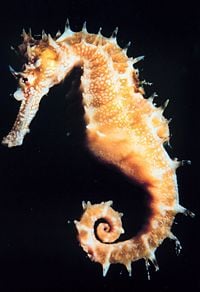
Hippocampus sp.
|
||||||||||||
| Scientific classification | ||||||||||||
|
||||||||||||
|
|
||||||||||||
See text for species. |
Seahorse is the common name for any of the small, marine, upright-swimming fish comprising the genus Hippocampus of the family Syngnathidae, characterized by a forward-curled, prehensile tail, a thin skin covering a series of bony plates in rings, an elongated head and snout suggestive of a horse, and brood organ on the tail of the male. There are over 32 species of seahorse, mainly found in shallow tropical and temperate waters throughout the world.
Seahorses provide important values for the ecosystem and for humans. Ecologically, they are important in food chains, consuming tiny fish, small shrimp, and plankton, and being consumed by larger fish (such as tuna and rays) and crabs.
For humans, the interesting form and behaviors of these fish add to the wonder of nature. For one, the seahorse, along with other members of the Syngnathidae family (pipefishes), are unique in terms of "male pregnancy," with the males having a brood organ into which the female places her eggs, with the male caring for the eggs and giving birth. Their courtship and reproductive behaviors, in which the female may visit the male daily after she has deposited the eggs, along with the prehensile tails, upright swimming motion, and hanging onto vegetation and mates with their tails, all adds to a special experience of nature.
Seahorses also are used in Traditional Chinese Medicine. Seahorse populations are thought to have been endangered in recent years by overfishing and habitat destruction.
Overview and description

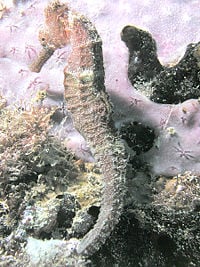
Syngnathidae, the family to which seahorses belong, is variously placed in the Syngnathiformes or Gasterosteiformes order. Nelson (2006) places seahorses in the suborder Syngnathoidei within Gasterosteiformes. Members of Syngnathoidei are characterized by a small mouth at the end of a tube-shaped snout (with one extant exception, the pipefish genus Bulbonaricus), abdominal pelvic fins, and an upper jaw that is not protractile. Members of the Syngnathidae family, the seahorse and pipefishes, are characterized by an elongate body that is encased in a series of bony rings, one dorsal fin, a very small anal fin, and an aglomerular kidney present only on the right side (Nelson 2006).
The Hippocampus genus, the seahorses, is one of about 50 genera in Syngnathidae, but is the only genus in the subfamily Hippocampinae (Nelson 2006). Seahorses are all marine. They are so named for their equine profile, with a long snout and head reflective of a horse.
Although they are bony fish, seahorses do not have scales, rather a thin skin stretched over a series of bony plates arranged in rings throughout their body. Each species has a distinct number of rings. Seahorses have a coronet on their head, which is distinct to each seahorse, much like a human fingerprint. They have long snouts, which they use to suck up food, and eyes that can move independently of each other much like a chameleon.
Seahorses swim upright, another characteristic that is not shared by their close pipefish relatives, which swim horizontally. Seahorses swim very poorly by using a dorsal fin, which they rapidly flutter to propel them, and pectoral fins, located behind their eyes, which they use to steer. Seahorses have no caudal fin. Because they are poor swimmers, they are most likely to be found resting in beds of sea grass or coral reefs, with their prehensile tails wound around a stationary object.
Seahorses are found in tropical and warm temperate marine waters throughout the world. Most are confined to shallow waters. They prefer to live in sheltered areas, such as sea grass beds, coral reefs, or mangroves.
From North America down to South America there are approximately four species, ranging from very small in size (dwarf seahorses are only about an inch long) to those much larger, found off the Pacific Coast of Central America (the foot-long Hippocampus ingens). Hippocampus erectus are larger seahorses found anywhere from Nova Scotia down to around Uruguay. Colonies have been found in European waters such as the Thames Estuary (BBC 2008).
Seahorses form territories, with males staying in about one square meter of their habitat while females range about one hundred times that area. They bob around in sea grass meadows, mangrove stands, and coral reefs where they are camouflaged by murky brown and gray patterns that blend into the sea grass backgrounds. During social moments or in unusual surroundings, seahorses turn bright colors. Seahorses eat small shrimp, tiny fish, and plankton.
Reproduction
Members of the Syngnathidae family of fishes (pipefishes and seahorses) have the unique characteristic where females lay their eggs in a special place on the undersurface of the trunk or tail, which may or may not be developed into a pouch, and the male incubates the eggs (Nelson 2006). Seahorses, as with most genera of Syngnathidae, have this brood organ on the tail, rather than the trunk (Nelson 2006).
Fertilization may take place in the pouch or before implantation in the water. Syngnathidae is the only family in the animal kingdom to which the term "male pregnancy" has been applied (Jones and Avise 2003).
Courtship
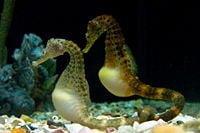
When two parties discover a mutual interest at the beginning of breeding season, they court for several days, even while others try to interfere. During this time, they have been known to change color, swim side by side holding tails or grip the same strand of sea grass with their tails, and wheel around in unison in what is known as their “pre-dawn dance.” They eventually engage in their “true courtship dance” lasting about 8 hours, during which the male pumps water through the egg pouch, which expands and cleaves open to display an appealing emptiness.
When the female’s eggs reach maturity, she and her mate let go of any anchors and, snout-to-snout, drift upward out of the seagrass, often spiraling as they rise. The female deposits her eggs into the male brood organ, using her ovipositor; the male then fertilizes the eggs and the fertilized eggs become embedded into the wall of the brood organ and become enveloped with tissues (Project Seahorse 2008a). New research indicates the male releases sperm into the surrounding sea water during fertilization, and not directly into the pouch as was previously thought.
As the female squirts anywhere from dozens to thousands of eggs from a chamber in her trunk into the male's brood organ, her body slims while his swells. Both seahorses then sink back to the bottom and she swims off. Scientists believe the courtship behavior serves to synchronize the movements of the two animals so that the male can receive the eggs when the female is ready to deposit them. The eggs are then fertilized in the father’s pouch, which is coursed with prolactin, the same hormone responsible for milk production in pregnant women. He does not supply milk, but his pouch provides oxygen as well as a controlled environment incubator. The eggs then hatch in the pouch where the salinity of the water is regulated. This prepares the newborns for life in the sea (Milius 2000; Danielson 2002).
Throughout the male’s incubation, his mate may visit him daily for “morning greetings.” The female seahorse swims over for about 6 minutes of interaction reminiscent of courtship. They may change color, move around sea grass fronds, and promenade holding one another's tails, with the female swimming away the next morning (Milius 2000).
Birth
The male seahorse can give birth to as few as 1 and as many as 2,000 "fry" at a time and pregnancies last anywhere from two to four weeks, depending on the species (Project Seahorse 2008a). When the fry are ready to be born, the male undergoes muscular contractions to expel them from his pouch. He typically gives birth at night and is ready for the next batch of eggs by morning when his mate returns.
Like almost all other fish species, seahorses do not care for their young once they are born. Infants are susceptible to death from predators or being swept into ocean currents, where they drift away from rich feeding grounds or into temperatures too extreme for their delicate bodies. Fewer than five infants of every 1,000 born survive to adulthood, helping to explain why litters are so large. The survival rates of these infants are actually fairly high compared to fish standards, because they are initially sheltered in their father’s pouch during the earliest stages of development, while the eggs of most other fish are abandoned immediately after fertilization (Danielson 2002). This makes the process worth the great cost to the father of incubating his offspring.
Energy costs
This entire reproductive process costs the male a great amount of energy. This brings into question why the sexual role reversal even takes place. In an environment where one partner incurs more energy costs than the other, one would expect the one with less energy costs of the two to be the aggressor. Within the seahorse species, males are shown to be the more aggressive sex and sometimes “fight” for female attention. According to Amanda Vincent of Project Seahorse, only males tail-wrestled and even snap their heads toward each other. This discovery prompted further study in finding out whether males actually are incurring more costs than their female counterparts.
To estimate the female’s direct contribution, researcher Heather D. Masonjones of Amherst College performed a chemical analysis of the energy stored in each egg. Furthermore, to measure the toll that incubation takes on a male, Masonjones built a tiny respirator that records oxygen concentrations in water flowing into and out of a chamber. Before a male took on eggs, she checked his baseline need for oxygen. Then, she monitored the increase as the incubation progressed. The male’s body had to work hard by the end of incubation, consuming almost a third again as much oxygen as he did before mating. To correct for oxygen used by the growing brood, Masonjones managed to keep ¼ inch-high premature seahorses alive outside the pouch so she could measure their oxygen needs. Although they undergo weeks of incubation, males directly contribute only half as much energy for offspring as females do (Milius 2000). Therefore, they do in fact fit into the widespread pattern of the less-invested sex being the less-choosy.
Adaptations
The question of why it is the males who undergo pregnancy rather than the females is actually not entirely known, though some researchers believe male pregnancy allows for shorter birthing intervals, hence more offspring.
When looking at which sex has the ability to produce more young if they had an unlimited number of ready and willing partners, males have the potential to produce 17 percent more in a breeding season. Also, females have “time-outs” from the reproductive cycle that are 1.2 times longer than those of males. This does not seem to be based on physiology, rather mate choice. When the female’s eggs are ready, she must lay them in a few hours or else she has to eject them onto the sea floor, which is a huge cost to her physically, as her eggs amount to about a third of her body weight. To protect against unwillingly losing a clutch, the female demands a long courtship period. Furthermore, the daily greetings help to cement the bond between the pair.
Another study conducted by Amanda Vincent of Project Seahorse shows the importance of this daily ritual. She kept a female in a tank with two males and when the female filled one male’s pouch with eggs he was then taken away, while she was left with the other male (the one not impregnated). During the weeks of her mate’s pregnancy, the female and her tankmate greeted each other daily, clinging to the same bit of grass and changing color, but according to Vincent did not display signs of serious courtship. When the original mate had given birth, he was returned to the tank. The female then had a choice between him and the other tankmate. While both males expressed enthusiasm for her attention, even tail wrestling and whacking each other, in all six tests the female rejected her original mate and presented the next clutch of eggs to the tankmate that she had greeted each day (Milius 2000).
The importance of the daily meeting is extremely high in maintaining their monogamous relationship. Although monogamy within species is not common, it does appear to exist for some. In this case, the mate-guarding hypothesis is a possible explanation. This hypothesis states that “males remain with a single female because of ecological factors that make male parental care and protection of offspring especially advantageous” (Alcock 2005). Because the rates of survival for newborn seahorses are so low, incubation is essential at the beginning stages of life. Though not proven, males could have taken on this role because of the time period in which it takes females to produce their eggs. If the males carry the offspring while the females gather the nutrients needed to produce new eggs (which is again, 1/3 of their body weight), then they can continually reproduce batch after batch together, depending on one another for efficiency in spreading both of their genes.
Importance to humans
Pets
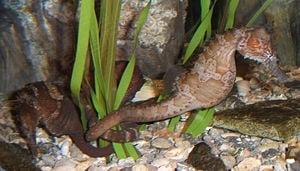
While many aquarium hobbyists will keep seahorses as pets, seahorses collected from the wild tend to fare poorly in a home aquarium. Many will eat only live foods such as ghost shrimp and are prone to stress in an aquarium, which lowers the efficiency of their immune systems and makes them susceptible to disease.
In recent years, however, captive breeding of seahorses has become increasingly widespread. These seahorses survive better in captivity, and they are less likely to carry diseases. These seahorses will eat prepackaged, frozen mysis shrimp that are readily available from aquarium stores, and they do not experience the shock and stress of being taken out of the wild and placed in a small aquarium. Although captive-bred seahorses are more expensive, they survive better than wild seahorses, and take no toll on wild populations.
Seahorses should be kept in an aquarium to themselves, or with compatible tank-mates. Seahorses are slow feeders, and in an aquarium with fast, aggressive feeders, the seahorses will be edged out in the competition for food. Special care should be given to ensure that all individuals obtain enough food at feeding times.
Seahorses can co-exist with many species of shrimp and other bottom-feeding creatures. Fish from the goby family also make good tank-mates. Some species are especially dangerous to the slow-moving seahorses and should be avoided completely: eels, tangs, triggerfish, squid, octopus, and sea anemones (Wooten 2004).
Animals sold as "freshwater seahorses" are usually the closely related pipefish, of which a few species live in the lower reaches of rivers. The supposed true "freshwater seahorse" called Hippocampus aimei was not a real species, but a name sometimes used for individuals of Barbour's seahorse (Hippocampus barbouri) and hedgehog seahorse (Hippocampus spinosissimus). The latter is a species that can be found in brackish waters, but is not actually a freshwater fish (Froese and Luna 2008).
Use in Chinese medicine
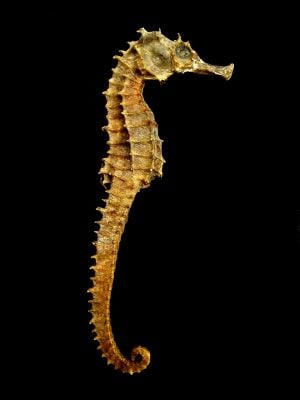
The seahorse is used in traditional Chinese herbology, and as many as 20 million seahorses may be caught each year and sold for this purpose (PBS 1997). Medicinal seahorses are not readily bred in captivity as they are susceptible to disease and are considered to have somewhat different energetics than aquarium seahorses.
Import and export of seahorses has been controlled under CITES since May 15, 2004. However, Indonesia, Japan, Norway, and South Korea have chosen to opt out of the trade rules set by CITES (Project Seahorse 2008b).
The problem may be exacerbated by the growth of pills and capsules as the preferred method of ingesting medication, as they are cheaper and more available than traditional, individually tailored prescriptions of raw medicinals, but the contents are harder to track. Seahorses once had to be of a certain size and quality before they were accepted by TCM practitioners and consumers. But declining availability of the preferred large, pale and smooth seahorses has been offset by the shift towards prepackaged medicines, which make it possible for TCM merchants to sell previously unused juvenile, spiny and dark-colored animals. Today almost a third of the seahorses sold in China are prepackaged. This adds to the pressure on the species (Parry-Jones and Vincent 1998).
Evolution and fossil record
Anatomical evidence, supported by molecular and genetic evidence, suggests that seahorses are highly modified pipefish. The fossil record of seahorses, however, is very sparse. The best known and best studied fossils are from the Marecchia River Formation of Rimini Province, Italy, dating back to the Lower Pliocene, about 3 million years ago. The earliest known seahorse fossils are of a pipefish-like species from the "Coprolitic Horizon" of Tunjice hills, a lower Miocene lagerstatten in Slovenia dating back about 13 million years.
Species

- Genus Hippocampus
- Big-belly seahorse, Hippocampus abdominalis Lesson, 1827 (New Zealand and south and east Australia)
- Winged seahorse, Hippocampus alatus Kuiter, 2001
- West African seahorse, Hippocampus algiricus Kaup, 1856
- Narrow-bellied seahorse, Hippocampus angustus Günther, 1870
- Barbour's seahorse, Hippocampus barbouri Jordan & Richardson, 1908
- Pygmy seahorse, Hippocampus bargibanti Whitley, 1970 (West Pacific area (Indonesia, Philippines, Papua New Guinea, Solomon Islands, etc)
- False-eyed seahorse, Hippocampus biocellatus Kuiter, 2001
- Réunion seahorse, Hippocampus borboniensis Duméril, 1870
- Short-head seahorse or knobby seahorse, Hippocampus breviceps Peters, 1869 (south and east Australia)
- Giraffe seahorse, Hippocampus camelopardalis Bianconi, 1854
- Knysna seahorse, Hippocampus capensis Boulenger, 1900
- Hippocampus colemani Kuiter, 2003
- Tiger tail seahorse, Hippocampus comes Cantor, 1850
- Crowned seahorse, Hippocampus coronatus Temminck & Schlegel, 1850
- Denise's pygmy seahorse, Hippocampus denise Lourie & Randall, 2003
- Lined seahorse, Hippocampus erectus Perry, 1810 (east coast of the Americas, between Nova Scotia and Uruguay)
- Fisher's seahorse, Hippocampus fisheri Jordan & Evermann, 1903
- Sea pony, Hippocampus fuscus Rüppell, 1838 (Indian Ocean)
- Big-head seahorse, Hippocampus grandiceps Kuiter, 2001
- Long-snouted seahorse, Hippocampus guttulatus Cuvier, 1829
- Eastern spiny seahorse, Hippocampus hendriki Kuiter, 2001
- Short-snouted seahorse, Hippocampus hippocampus (Linnaeus, 1758) (Mediterranean Sea and Atlantic Ocean)
- Thorny seahorse, Hippocampus histrix Kaup, 1856 (Indian Ocean, Persian Gulf, Red Sea, and the Far East)
- Pacific seahorse, Hippocampus ingens Girard, 1858 (Pacific coast of North, Central and South America)
- Jayakar's seahorse, Hippocampus jayakari Boulenger, 1900
- Collared seahorse, Hippocampus jugumus Kuiter, 2001
- Great seahorse, Hippocampus kelloggi Jordan & Snyder, 1901
- Spotted seahorse, Hippocampus kuda Bleeker, 1852
- Lichtenstein's seahorse, Hippocampus lichtensteinii Kaup, 1856
- Bullneck seahorse, Hippocampus minotaur Gomon, 1997
- Japanese seahorse, Hippocampus mohnikei Bleeker, 1854
- Monte Bello seahorse, Hippocampus montebelloensis Kuiter, 2001
- Northern spiny seahorse, Hippocampus multispinus Kuiter, 2001
- High-crown seahorse, Hippocampus procerus Kuiter, 2001
- Queensland seahorse, Hippocampus queenslandicus Horne, 2001
- Longsnout seahorse, Hippocampus reidi Ginsburg, 1933 (Caribbean coral reefs)
- Half-spined seahorse, Hippocampus semispinosus Kuiter, 2001
- Dhiho's seahorse, Hippocampus sindonis Jordan & Snyder, 1901
- Hedgehog seahorse, Hippocampus spinosissimus Weber, 1913
- West Australian seahorse, Hippocampus subelongatus Castelnau, 1873
- Longnose seahorse, Hippocampus trimaculatus Leach, 1814
- White's seahorse, Hippocampus whitei Bleeker, 1855 (east Australia)
- Zebra seahorse, Hippocampus zebra Whitley, 1964
- Dwarf seahorse, Hippocampus zosterae Jordan & Gilbert, 1882 (Gulf of Mexico and the Caribbean)
References
ISBN links support NWE through referral fees
- Alcock, J. 2005. Animal Behavior: An Evolutionary Approach, 8th edition. Sunderland, MA: Sinauer. ISBN 0878930051.
- BBC. 2008. Rare seahorses breeding in Thames. BBC News, April 7, 2008. Retrieved December 21, 2008.
- Connor, S. 2007. Sex and the seahorse: Scientists have solved one of the most baffling riddles of these mysterious creatures—how they reproduce. The Independent(UK) January 19, 2007.
- Danielson, S. 2002. Seahorse fathers take reins in childbirth. National Geographic News June 14, 2002. Retrieved December 21, 1008.
- Froese, R., and S. M. Luna. 2008. Hippocampus spinosissimus, hedgehog seahorse. Fishbase.org. Retrieved December 21, 2008.
- Jones, A. G., and J. C. Avise. 2003. Male pregnancy Current Biology 13(20): R791. Retrieved September 18, 2008.
- Milius, S. 2000. Pregnant—and still macho—seahorses. Science News March 11, 2000. Retrieved December 21, 2008.
- Nelson, J. S. 2006. Fishes of the World, 4th edition. Hoboken, NJ: John Wiley & Sons. ISBN 0471250317.
- Parry-Jones, R., and A. Vincent. 1998. Can we tame wild medicine?. New Scientist 157(2115): 26. Retrieved December 21, 2008.
- PBS. 1997. Seahorse crusader Amanda Vincent. Nova. Retrieved December 21, 2008.
- Project Seahorse. 2008a. The biology of seahorses: Reproduction. Project Seahorse. Retrieved December 21, 2008.
- Project Seahorse. 2008b. A new hurdle for seahorses. Project Seahorse. Retrieved December 21, 2008.
- Vincent, A. C. J., and L. M. Sadler. 1995. Faithful pair bonds in wild seahorse Hippocampus whitei]. Animal Behaviour 50: 1557-1569.
- Vincent, A. C. J. 1995. A role for daily greetings in maintaining seahorse pair bonds. Animal Behaviour 49: 258-260.
- Vincent, A. C. J. 1990. A seahorse father makes a good mother. Natural History 12: 34-43.
- Vincent, A. C. J., and R. Woodroffe. 1994. Mothers little helpers: Patterns of male care in mammals. Trends in Ecology and Evolution 9: 294-297.
- Wooten, W. 2004. Seahorse tankmates: What's safe? What's not?. World of Syngnathiformes. Retrieved December 21, 2008.
Credits
New World Encyclopedia writers and editors rewrote and completed the Wikipedia article in accordance with New World Encyclopedia standards. This article abides by terms of the Creative Commons CC-by-sa 3.0 License (CC-by-sa), which may be used and disseminated with proper attribution. Credit is due under the terms of this license that can reference both the New World Encyclopedia contributors and the selfless volunteer contributors of the Wikimedia Foundation. To cite this article click here for a list of acceptable citing formats.The history of earlier contributions by wikipedians is accessible to researchers here:
- Seahorse history
The history of this article since it was imported to New World Encyclopedia:
- History of "Seahorse"
Note: Some restrictions may apply to use of individual images which are separately licensed.
↧ Download as ZWI file | Last modified: 02/03/2023 22:51:21 | 23 views
☰ Source: https://www.newworldencyclopedia.org/entry/Seahorse | License: CC BY-SA 3.0
 ZWI signed:
ZWI signed: KSF
KSF